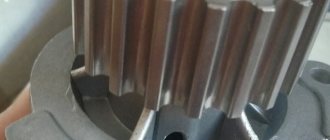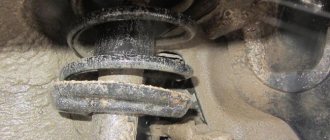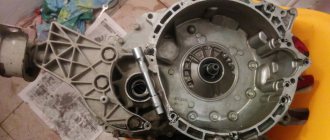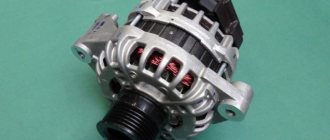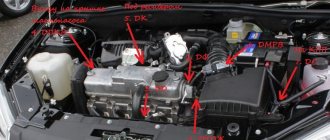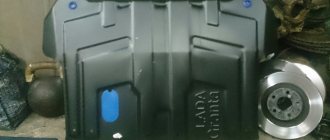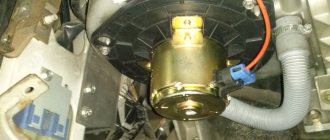Creaks are present even in the basic configurations of the Lada Granta Liftback, despite being equipped with noise and vibration insulation. This causes significant discomfort to the driver while driving.
Eliminating squeaks is not an easy, labor-intensive, and costly procedure. Not all owners willingly agree to do this in a service station. In order to save money, car enthusiasts practice doing noise reduction with their own hands. Read below about how to do this on a Lada Granta Liftback.
Where does the squeak come from?
The creaking sounds of car doors opening are a consequence of metal elements rubbing against each other. Door lock pins become clogged:
- road dirt;
- dust;
- sand;
- reagents;
- moisture.
This gradually corrodes and dries out the factory lubricant. The lack of lubricant leads to corrosion on the mechanisms - the door begins to creak.
Old pins also cause unpleasant sounds. They can no longer cope with the assigned load, so the car doors sag, causing a grinding noise due to metal parts rubbing against each other. After installing the new mechanisms, the creaking is not heard.
A car door will squeak if its lock is not set correctly. Many drivers in this situation make the mistake of lubricating or filling the hinges with locks using whatever comes to hand. This “treatment” of mechanisms has a short-term effect - soon the creaking of the car door returns.
Express method
In this article we will look at one of the fastest ways to lubricate rubbing surfaces in Lada Granta door mechanisms. For this, we will use Hi-Gear aerosol silicone lubricant, which is very similar to WD-40, but is not its analogue, since their composition is very different.
Some will argue that silicone lubricant is intended exclusively for rubber and plastic parts. However, on the can, in the first place in the list we see “for metal”. Obviously, the manufacturer took care of special additives that provide the lubricant with the necessary properties.
This method is called the “express method” because it does not involve unscrewing the door hinge axis (cone bolt) for subsequent application of grease. Of course, lubricating car door hinges with silicone grease is not the best way, since the lubricating effect does not last as long as when using grease, but it is very simple and fast.
If you have enough time and desire, it is better to lubricate the door hinges thoroughly. This will be discussed in a separate article, but for now we’ll make do with silicone lubricant.
The lubrication procedure is very simple, so I won’t tell you much, just watch it and you’ll understand everything. So let's get started.
Lubricating door handles. First, let's lubricate the door handles. To do this, pull the handle towards you and spray lubricant into the openings formed.
Lubrication of keyholes. Then we insert the tube into the keyhole and spray the lubricant there. Remove excess grease with a rag.
Lubricating the door lock. Next, open the doors and lubricate the inside of the door lock.
Lubricating door hinges. Lubricate the upper and lower door hinges.
Lubricating the door stop. Next, lubricate the limiter and its rubbing surfaces.
We lubricate all other doors in the same way: door handles, lock cylinders, the inside of the lock, door hinges and the stopper.
Lubricating the springs of the fuel tank hatch. According to the regulations, you also need to lubricate the gas tank flap, or rather its spring in places of friction.
Since I had already started lubricating the locks, I decided to lubricate the hood lock at the same time, spraying all the rubbing parts.
The trunk lock was also not spared.
At this point, perhaps, the routine work on lubricating door locks and rubbing surfaces can be considered completed. You can also watch a short video on this topic.
Limiter device
The limiter is quite simple. There is a rod, on one side it is rigidly attached to the body panel, on the other - to the door, inside of which it runs along a special opening. The opening is equipped with plastic bushings. The rod is equipped with one or more protrusions necessary for fixing the door in various positions. For example, so that it does not slam shut from strong winds.
It is not surprising that a rod made of metal quickly wears out plastic bushings. To avoid this, you should regularly apply a certain lubricant to moving parts. Its deficiency or absence results in creaking when opening the car.
Door stop creaking and clicking
If you hear not only a creaking car door, you already know how to fix it, but also a clicking sound, pay attention to probably worn bushings. The rod moves freely in them, accompanying its actions with clicks. The only way to get rid of the problem is to remove the structure, then change the inserts.
You can do this yourself - today in every car store you can find repair kits for any brand of car. You remove the frame, lubricate the parts, put it back, and enjoy the silence of the car being opened.
Do not repair or lubricate the limiters with anything - this does not make any sense.
Eliminating rattling side windows on Lada Granta, Kalina and Priora
03 June 2022 LadaOnline 48 085 Many owners of Lada Granta, Kalina or Priora cars notice rattling in the doors when they are closed. If a similar strumming noise appears when the windows are open, then the cause of this extraneous noise is in the seal. The problem can be solved with a simple modification.
Question to AvtoVAZ via Za Rulem: When will the window seals on Grants be replaced? The windows are rattling! And is it possible to make the doors like on all cars in the world - so that the top is hidden under the roof, and not on top?
Work is underway to solve the problem with the seals, but it is not very easy. A complete redesign of the door and roof design is only possible when developing a new car. This was taken into account on Lada Vesta.
Machine oil and nigrol
Nigrol is a fairly liquid product, so you can only fill the loops with it using a syringe. When it gets on the mechanism, the substance literally flows. Excessive application of nigrol can seriously contaminate the door, along with the thresholds and glass. Just lubricate moving parts without any extra effort.
Excess drops flowing down are difficult to remove even with a wet rag. Nigrol has water-repellent properties, so only a dry cloth can get rid of it. For greater effect, before work, clean the mechanisms of old grease and various blockages, then degrease the treated areas.
Why not LITOL, SOLIDOL, WD-40 and SILICONE
All these products are not suitable for door mechanisms, as they reduce friction. The squeak will disappear, but another problem will appear. When using silicone, lithol, grease or WD-40, the door will swing open or slam shut due to gusts of wind, as it will not be able to stay in the special grooves.
In addition, the listed lubricants “love” to stick a lot of debris on themselves - sand, dirt, dust. Subsequently, this debris behaves like an abrasive - it causes strong friction between parts, which leads to rapid wear of the plastic inserts.
Known to every driver, WD-40 is an excellent solvent. It has proven to work well as a lubricant, but can quickly corrode seals.
Door hinges
Hinges are used quite often in vehicle design. This mainly concerns door mechanisms. There are several common options for which lubricant to use for your car's door hinges. Hinges are not the most demanding elements, but it is still better to know exactly what kind of lubricant should be used, and what is not recommended to lubricate with. Using the right lubricant, you will not encounter unpleasant squeaks or problems when opening and closing doors.
- Wurth 2000. A common and effective lubricant that falls into the synthetic category. Can be used when processing hinges, locks, gears, etc. Penetrates perfectly into cracks and gaps, forms a stable protective film;
- Multigliss from Molykote. A product with approximately the same properties as the previous lubricant. One of the best solutions in terms of price and quality. Although slightly inferior to Wurth in physical and chemical properties;
- Movil. An inexpensive but effective lubricant that can efficiently cope with its tasks. It is important to apply to a thoroughly cleaned surface to achieve maximum results.
There are many examples of good lubricants. Try to give preference to proven and well-established manufacturers. Don't take risks by buying cheap lubricants or compounds that you know nothing about and have never heard of.
Special lubricants
If earlier car service technicians used ordinary soap to lubricate door elements, now specialized products are made to “treat” creaking locks and hinges. Many of them contain Teflon.
Such coatings have the consistency of dry soap, and due to the absence of a greasy film, they resist the adhesion of sand, dirt, and dust. The only drawback of Teflon auto lubricants is their price. But the high cost is compensated by a long service life - about two years. Although soap protects mechanisms about the same - 1-2 years.
How to apply
The method of applying lubricant to hinges and door locks depends on the product chosen. If you have settled on nigrol, then you cannot do without a medical syringe. The needle is removed from the syringe, nigrol is drawn into it, and then carefully poured into special hinged caps. Do not overdo it - excess lubricant will flow down, staining the threshold.
Thick coatings are usually applied with brushes, and if you choose soap, then you can simply rub the rubbing mechanisms with its corner. At the same time, open/close the door so that the product penetrates deeper inside. You should not make a soap solution and then pour it into the hinges - such a lubricant will only help for a short time.
The easiest way to work is with sprays - they create an oily film on the parts, eliminating squeaking. It is necessary to spray the substance from the can at a distance directly onto the communicating elements, while closing/opening the door several times for better penetration of the spray.
Before processing, wipe the rod with a paper napkin or dry rag to remove old grease and various debris.
Doors creaking or something related to them
Hi all! No one has had this happen when you drive over smooth uneven surfaces or move from rut to rut, the body of the car seems to twist and the rear doors creak at the same time, I tried pulling the closed door handle up and down, there is also a creak, but I don’t understand where it comes from. How and what to treat? Thank you in advance for your cooperation!
Most likely, it’s not the doors that are creaking, but the handbrake cable—it rubs against the body and makes a sound similar to “the creaking of an old sofa.” On viburnums the same crap, there are a lot of solutions (remove the cable from the holder or put a piece of hose on the cable and tuck it back into the holder, etc.).
No, when the door is closed, when you pull the door down from the street, the locks seem to creak terribly.
Then try to adjust the lock mate (which is on the body), look at the door hinges to see if the hinge bolts are fully tightened.
I need to take a look, spray it with WD 40, I’ll do it after work, otherwise this sound is already infuriating, like you’re driving a cart(
the plastic bushings squeak on the part of the lock that is on the body, apply some kind of lubricant and the squeak should go away, at first I thought the glass in the doors squeaked, I put the seal in the rubber bands but it didn’t do any good, then I opened the closed door, I heard a familiar squeak and it dawned on me that these are bushings.
Hmm, wouldn't it be easier to change the bushings and add a little lithol?;)
the plastic bushings squeak on the part of the lock that is on the body, apply some kind of lubricant and the squeak should go away, at first I thought the glass in the doors squeaked, I put the seal in the rubber bands but it didn’t do any good, then I opened the closed door, I heard a familiar squeak and it dawned on me that these are bushings.
Thanks buddy, I solved the problem!
I’m glad that it helped, I still have a creaking sound, as if the rear parcel shelf, the sound is like rubber rubbing against iron, I moved the shelf, there is no sound, they write that the handbrake cable also creaks, yesterday I changed the wheels, put on summer tires, I looked at the cable, there is dirt stuck to it, no it’s clear that he was fidgeting.
I also have a sound in the area of the back row of seats, similar to rubber on iron... I think it’s from the covers
I’m glad that it helped, I still have a creaking sound, as if the rear parcel shelf, the sound is like rubber rubbing against iron, I moved the shelf, there is no sound, they write that the handbrake cable also creaks, yesterday I changed the wheels, put on summer tires, I looked at the cable, there is dirt stuck to it, no it’s clear that he was fidgeting.
Have you resolved the issue with the knocking noise from the rear? Something is also hitting me, I’ve already looked at the shelf and the jack and headrests.(
I also had a knock from behind, I searched for the source for a long time and finally found it. The trunk lid lock was noisy. On bumps, it hits the eyelet on the body, on which it snaps. You just need to wrap this eyelet on the body with soft electrical tape. I'm quiet now)
I had this thought, but it remained in the subconscious) ) I’ll try, thank you! I'll unsubscribe!
I also had a knock from behind, I searched for the source for a long time and finally found it. The trunk lid lock was noisy. On bumps, it hits the eyelet on the body, on which it snaps. You just need to wrap this eyelet on the body with soft electrical tape. I'm quiet now)
You were right, thank you!) Only I turned the ear over as it was before, because... Before that I installed it the other way around and the trunk closed easier. Now I have to clap harder, but the knocking is gone!)
Well, since we’re talking about squeaks and abrasions, I’ll add it and take a look for yourself, please write back - the rear doors at the top at the corners are rubbing against the rubber on the roof (gutter) and have already rubbed small spots to the metal on the inside of the door ((
I’m rubbing, I watched a video of children’s sores grants, I think that’s what it was called, it advises sticking duct tape on these places, and when it wears off, reapply it again.
The search for a video under that name was unsuccessful(((
I’m rubbing, I watched a video of children’s sores grants, I think that’s what it was called, it advises sticking duct tape on these places, and when it wears off, reapply it again.
You can also try gluing the rubber band on the roof to the body somehow. It sticks up, so it rubs ((
and if, as an option, stick a madeline strip on the inside of the door in contact with the drain.
I’m rubbing, I watched a video of children’s sores grants, I think that’s what it was called, it advises sticking duct tape on these places, and when it wears off, reapply it again.
You don’t need to use any electrical tape to cover the door... it’s enough to bend the door geometry correctly... I myself had a scuff on the back left... I took it to a door lock adjuster and everything was fine
Well, since we’re talking about squeaks and abrasions, I’ll add it and take a look for yourself, please write back - the rear doors at the top at the corners are rubbing against the rubber on the roof (gutter) and have already rubbed small spots to the metal on the inside of the door ((
I went to the official and everything was fixed in two days.
I mean, did they do something with the rubber band and paint the door?
The door was painted and adjusted; it was pressed tightly in this place. Now he’s not rubbing anything)
Well, since we’re talking about squeaks and abrasions, I’ll add it and take a look for yourself, please write back - the rear doors at the top at the corners are rubbing against the rubber on the roof (gutter) and have already rubbed small spots to the metal on the inside of the door ((
I watched a video about how to get rid of this. The fact is that the geometry of the door is not entirely correct; in short, they are bent towards the watercourse. The treatment is as follows: lower the windows, close the door one click and pull the upper part, which is in contact with the drain, towards you, but without fanaticism. The door should bend a little. It is necessary to achieve a gap between the top of the door and the drain, with it completely closed naturally. You need to bend it a little at a time, bend it, close it completely, check it. I did this myself, it’s good that I noticed it in time, it only wiped off my varnish. Now it doesn't rub. Good luck.
Well, since we’re talking about squeaks and abrasions, I’ll add it and take a look for yourself, please write back - the rear doors at the top at the corners are rubbing against the rubber on the roof (gutter) and have already rubbed small spots to the metal on the inside of the door ((
I also took off this rubber band and in some places it is already turning red from rust!((((the car is 4 months old!((
But I wonder if if you contact the officials, will the problem be fixed under warranty? Maintenance is coming up soon, so I think we need to bother with this door
Source
If they're rusty
Without regular maintenance, door devices, as well as thresholds and arches, quickly become covered with rust. How to eliminate car doors squeaking when opening? If corrosion has been embedded in the mechanisms for a long time and tightly, then a single application of lubricant will not be enough. You should not apply several layers of the product - it is better to first remove the rust and then start coating the mechanisms. The applied product will eliminate the unpleasant sound and remove rust residues, but will not be able to penetrate deep into the hinge and corrode the corrosion from the inside.
What to do if there is no result
It is not uncommon for a car door to continue to squeak after treatment. Moreover, the sound is heard not when opening/closing, but when the car is moving. The reason may lie in sagging mechanisms. A crooked, hard-to-lock door is evidence of wear in the hinges.
Car owners solve this problem by replacing the pins, but the method does not always help: wear has affected not only them, but also the hinges. Even a couple of mm is enough for the metal to start “moving” inside. The solution is to score the ends of the loops with a grinder and then weld them. The gap becomes smaller - the pin fits tighter, and the door play disappears. The parts are first lubricated with a thick compound, often graphite lubricant.
When to treat
It is better to lubricate door hardware before the onset of cold weather. In winter, many coatings thicken. It is recommended to process not only the hinges, but also the locks on the doors, including the trunk. To remove ice from storm drains and seals, apply silicone grease.
After this treatment, the doors will not freeze throughout the winter. To lubricate locks, use WD-40 - apply the product through the key hole, slightly prying it. After this, the locking mechanism key is opened/closed several times in a row. This way the lubricant envelops the surfaces of all contacting elements inside.
A similar treatment of parts occurs after each car wash, especially in winter. Even thorough wiping with a rag will not be able to remove all the moisture from the rubber bands - after a couple of hours, the smallest drops will turn into ice.
Reviews
| № | Positive |
| 1. | Vitaly: a year has already passed since the purchase of Granta, I spent the night on the street in winter, there is no creaking. The dashboard is quiet. |
| 2. | Gennady: There are no complaints about the torpedo, it doesn’t make noise, it doesn’t creak. I installed acoustics at the service center, apparently it was a hack job. Two months later, the door card on the left side began to make noise. I put Madeline on it and it doesn’t make any noise. |
| 3. | Vasily: I heard from other owners that the panel creaks. I can’t confirm that it fits evenly and is not deformed. |
| 4. | Kirill: when buying a car, the dealership recommended a torpedo care product. I apply it systematically, cover it in the sun, there is no vibration. |
| 5. | Vladimir: after buying the car, I immediately retightened the instrument panel and lubricated it with silicone. No complaints, no noise, no knocking. |
| Negative | |
| 1. | Victor: No matter what I did with the torpedo, it’s constantly making noise. In the spring I plan to completely disassemble and glue it with rubber. Factory quality is poor. |
| 2. | Ignat: drove it one winter, after which the tidy began to rattle. I disassembled it, put in plastic inserts, and the extraneous sounds were eliminated. |
| 3. | Ivan: negative review about the factory assembly of the Lada Granta Liftback. Already in the third month of use, the panel began to rattle. |
Conclusion The human factor is present everywhere, including with the assembly of a torpedo on the Lada Granta Liftback.
It will not be difficult for the owner to tighten the plastic fastening points with a screwdriver within half an hour. It is important to follow the manufacturer's recommendations regarding protection from ultraviolet rays. Special rolls of foil are available for sale for this purpose.
In most cases, panel deformation is caused by violation of operating rules by the owner of the equipment.
| Video — LADA GRANTA LIFTBACK (creaking from the clutch pedal) |
| Video - Place of creaking in the trunk of Granta Liftback |
Prevention methods
To prevent your car door from creaking when opening, regularly lubricate the stops and hinges with a suitable product. Don’t be lazy - buy a 25 ml syringe at the pharmacy and treat the mechanisms at least once a year. Also, do not leave the car wash without drying your car for 5-10 minutes. Open/close the doors as you go, helping excess moisture escape.
In winter, it is better to use spray lubricants to treat locks and hinges, and coat rubber seals with silicone. Do not start the problem - at the first appearance of a squeak, lubricate the mechanisms. This way you will save your nerves and protect rubbing parts from rapid wear.
Soundproofing Kalina: competent instructions
03 June 2016 Lada.Online 66 067 2
Many owners of Lada Granta, Kalina or Priora cars notice rattling in the doors when they are closed. If a similar strumming noise appears when the windows are open, then the cause of this extraneous noise is in the seal. The problem can be solved with a simple modification.
via “Behind the Wheel”: When will the window seals on the Grants be replaced? The windows are rattling! And is it possible to make the doors like on all cars in the world - so that the top is hidden under the roof, and not on top?
Work is underway to solve the problem with the seals, but it is not very easy. A complete redesign of the door and roof design is only possible when developing a new car. This was taken into account on Lada Vesta.
